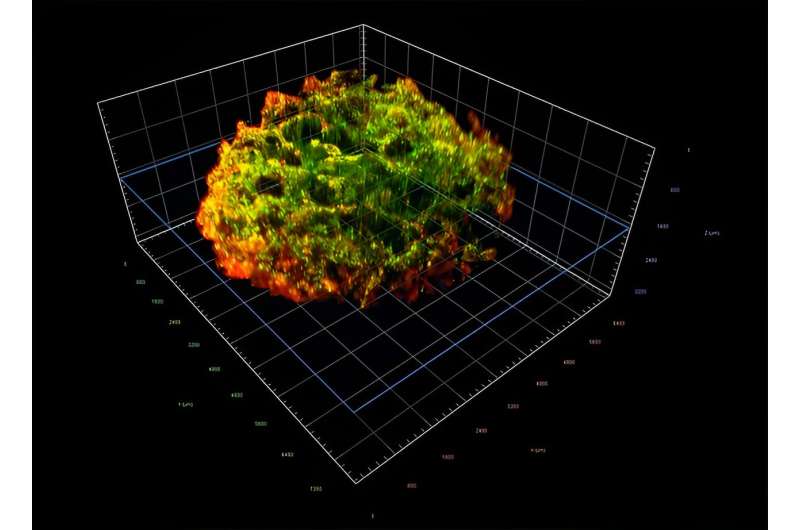This article has been reviewed according to Science X's editorial process and policies. Editors have highlighted the following attributes while ensuring the content's credibility:
fact-checked
peer-reviewed publication
trusted source
proofread
Mineralization of bone matrix regulates tumor cell growth

Tumor cells are known to be fickle sleeper agents, often lying dormant in distant tissues for years before reactivating and forming metastasis. Numerous factors have been studied to understand why the activation occurs, from cells and molecules to other components in the so-called tissue microenvironment.
Now, an interdisciplinary Cornell University team has identified a new mechanism regulating tumor growth in the skeleton, the primary site of breast cancer metastasis: mineralization of the bone matrix, a fibrous mesh of organic and inorganic components that determines the unique biochemical and biomechanical properties of our skeleton.
The team's paper, "Bone-Matrix Mineralization Dampens Integrin-Mediated Mechanosignalling and Metastatic Progression in Breast Cancer," published Aug. 7 in Nature Biomedical Engineering. The co-lead authors are research associate Siyoung Choi and doctoral student Matthew Whitman.
The project is the latest collaboration between co-senior authors Claudia Fischbach, the Stanley Bryer 1946 Professor of Biomedical Engineering, and Lara Estroff, the Herbert Fisk Johnson Professor of Industrial Chemistry, both in Cornell Engineering, who together have been exploring the metastatic spread of breast cancer to bone for more than a decade.
Fischbach's lab uses biomaterials in combination with cellular and tissue engineering approaches to understand how the tissue microenvironment regulates cancer in different contexts, while Estroff's group specializes in biomineralization—the way biological organisms control the growth of crystals in their tissues.
"We know that cancer cells behave like seeds that need the right soil to grow, and we're very interested in how the extracellular matrix, which is basically the material in between cells that holds everything together, affects tumor growth," Fischbach said.
During physiological mineralization, bone mineral particles are deposited in and around collagen type I fibers. This process occurs naturally and is necessary for bone health but decreases with age—for example, due to hormonal changes as seen in women undergoing menopause. It can also result from dietary changes or chemotherapy.
A connection between reduced bone health and the behavior of tumor cells is well-established. For example, decreased bone-mineral density has been correlated with increased risk for metastasis, and incomplete fracture healing has been shown to enhance bone metastasis. However, no one had been able to isolate which specific role bone-matrix mineralization plays in this process.
"You can't study some these connections unless you have model systems in which you can control bone matrix properties in a defined way," Fischbach said.
The researchers were able to create such systems by combining organic and inorganic matrix components, including collagen and the bone mineral hydroxyapatite, in a manner that mimicked physiological and pathologic mineralization. Estroff led the necessary materials synthesis and characterization techniques of the different bone matrix models, which the team then used to investigate tumor cell behavior, first in vitro and then in vivo through mouse models.
The presence of bone mineral reduced the growth of tumor cells in both settings. The presence of mineral also caused tumor cells to promote genes that were associated with better patient prognosis. These findings suggest that healthy bone matrix can reduce the risk for breast cancer skeletal metastasis.
Co-authors Matthew Paszek, associate professor in the Smith School of Chemical and Biomolecular Engineering, and Olivier Elemento, director of the Englander Institute for Precision Medicine and a professor of physiology and biophysics and of computational genomics in computational biomedicine at Weill Cornell Medicine, helped elucidate how bone matrix regulates cellular mechanosignaling, and connect the potential molecular mechanisms to patient data.
"This study basically shows for the first time that physiological interactions between mineral particles and collagen may be able to inhibit the activation of tumor cells that have spread to bone," Fischbach said. "Now we're broadly interested in how other cell types are influenced by varied bone-matrix mineralization. And how do mineral-dependent changes of their behavior regulate tumor cells?"
Co-authors include doctoral students Adrian Shimpi and Nicole Sempertegui; Aaron Chiou, Ph.D.; Joseph Druso, Ph.D.; Akanksha Verma, Ph.D.; alumna Stephanie Lux; and Zhu Cheng, Ph.D.
More information: Siyoung Choi et al, Bone-matrix mineralization dampens integrin-mediated mechanosignalling and metastatic progression in breast cancer, Nature Biomedical Engineering (2023). DOI: 10.1038/s41551-023-01077-3



















